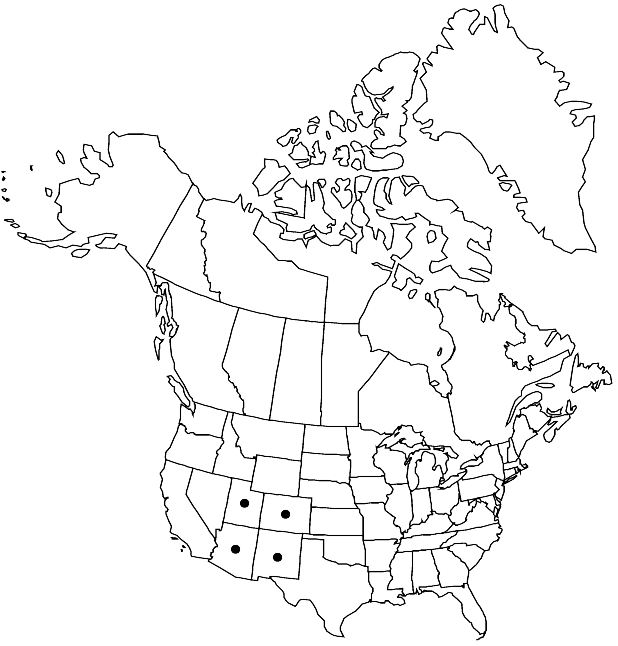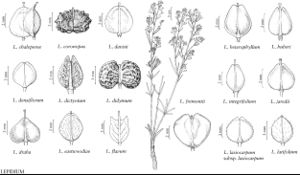Difference between revisions of "Lepidium eastwoodiae"
Bull. Torrey Bot. Club 25: 258. 1898.
FNA>Volume Importer |
FNA>Volume Importer |
||
| Line 57: | Line 57: | ||
|publication year=1898 | |publication year=1898 | ||
|special status= | |special status= | ||
| − | |source xml=https://jpend@bitbucket.org/aafc-mbb/fna-data-curation.git/src/ | + | |source xml=https://jpend@bitbucket.org/aafc-mbb/fna-data-curation.git/src/f6b125a955440c0872999024f038d74684f65921/coarse_grained_fna_xml/V7/V7_937.xml |
|tribe=Brassicaceae tribe Lepidieae | |tribe=Brassicaceae tribe Lepidieae | ||
|genus=Lepidium | |genus=Lepidium | ||
Revision as of 20:24, 24 September 2019
Annuals, biennials, or perennials; (base woody); glabrous or pubescent. Stems simple from base, erect, branched distally, (3.5–)4.5–16(–18) dm. Basal leaves (soon deciduous), not rosulate; petiole (1–)2–5.5(–7.5) cm; blade pinnatifid, (2–)3–6.8(–9) cm × 10–30 mm, margins (of lobes) dentate to serrate. Cauline leaves shortly petiolate or sessile; blade narrowly lanceolate or oblanceolate to linear, 3–7 cm × (2.5–)4–10mm (smaller distally), base attenuate to cuneate, not auriculate, margins usually entire, rarely dentate. Racemes elongated in fruit; rachis puberulent, trichomes straight or curved. Fruiting pedicels divaricate-ascending to horizontal, usually slightly recurved or somewhat sigmoid, rarely straight, (not winged), (3–)3.5–7.5(–8) × 0.2–0.3 mm, puberulent adaxially. Flowers: sepals suborbicular to oblong, 0.8–1.5 × 0.7–1.2 mm; petals white, suborbicular, 2.2–3.5(4) × 1.5–2.5 mm, claw 0.7–1.5 mm; stamens 6; filaments 1.5–2.5 mm, (glabrous); anthers 0.3–0.4 mm. Fruits broadly ovate, 2–3.5(–4) × 1.8–2.6(–3) mm, apically winged, apical notch 0.1–0.2mm deep; valves thin, smooth, not veined, glabrous; style (0.2–)0.3–0.6(–0.7) mm, exserted beyond apical notch. Seeds (dark brown), ovate, 1.4–1.8 × 0.8–1.1 mm.
Phenology: Flowering Jul–Sep.
Habitat: Pinyon-juniper, sagebrush, or mixed desert shrub communities
Elevation: 900-2200 m
Distribution

Ariz., Colo., N.Mex., Utah.
Discussion
C. L. Hitchcock (1936) and R. C. Rollins (1993) reduced Lepidium eastwoodiae to a variety of L. montanum and L. alyssoides, respectively. However, the differences in morphology and flowering periods support its recognition as an independent species.
We have not examined the holotype of Lepidium moabense and follow N. H. Holmgren (2005b) in reducing it to synonymy of L. eastwoodiae.
Selected References
None.
